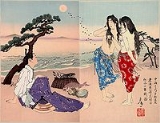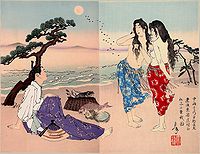
Matsukaze
Encyclopedia

Kanami
Kan'ami Kiyotsugu , was a Japanese Noh actor, author, and musician during the Muromachi period. Born Yūzaki Kiyotsugu in Iga Province, Kan'ami also went by the names 'Miyomaru' and 'Kanza Kiyotsugu' ....
, revised by Zeami Motokiyo
Zeami Motokiyo
Zeami Motokiyo , also called Kanze Motokiyo , was a Japanese aesthetician, actor and playwright.-Acting:...
. One of the most highly-regarded of Noh
Noh
, or - derived from the Sino-Japanese word for "skill" or "talent" - is a major form of classical Japanese musical drama that has been performed since the 14th century. Many characters are masked, with men playing male and female roles. Traditionally, a Noh "performance day" lasts all day and...
plays, it is mentioned more than any other in Zeami's own writings, and is depicted numerous times in the visual arts.
Plot
The two main characters are the lingering spirits of the sisters and , who once lived on the Bay of SumaSuma-ku, Kobe
is one of 9 wards of Kobe City in Japan. It has an area of 30.0 km², and a population of 168,400 .There is a white sandy beach in this ward, which attracts tourists to the Kansai region for sun bathing and popular events during the summer season. The same beach has appeared in the classic...
in Settsu Province
Settsu Province
was a province of Japan, which today comprises the eastern part of Hyōgo Prefecture and the northern part of Osaka Prefecture. It was also referred to as or .Osaka and Osaka Castle were the main center of the province.-History:...
, where they ladled brine in order to make salt. A courtier, Middle Counsellor Ariwara no Yukihira
Ariwara no Yukihira
was a Japanese Heian period courtier and bureaucrat, who held a number of positions over the course of his life. At one time or another, he was governor of the provinces of Harima, Bizen, Shinano, and Bitchū. He also served as , , and inspector of Mutsu and Dewa provinces.Yukihira was also a poet,...
, dallied with them during his exile to Suma for three years. Shortly after his departure, word of his death came and they died of grief. They linger on as spirits or ghosts, attached to the mortal world by their sinful (according to Buddhist doctrine) emotional attachment to mortal desires; this is a common theme in Noh.
The play opens with a traveling priest asking a local about a memorial he sees. The local explains that the memorial is to the two sisters. This is followed by a scene in which the sisters, ladling seawater into their brinecart at night, become fascinated by the sight of the moon in the water, and try to capture it.
The priest dreams that he meets them when asking for lodgings. After revealing their identities, they explain their past, and grow overcome with their love and longing for Yukihira. Matsukaze, after donning the courtly hunting robe and hat left her by the courtier, mistakes a pine for her love, and Murasame joins her briefly in madness, before recovering, passing on from the mortal world of emotional attachment, and leaving her sister behind.
Sources and themes
Royall TylerRoyall Tyler
Royall Tyler , American jurist and playwright who wrote The Contrast in 1787 and published The Algerine Captive in 1797. He wrote several legal tracts, six plays, a musical drama, two long poems, a semifictional travel narrative, The Yankey in London , and essays...
and other scholars attribute the bulk of the work to Zeami, claiming that it is based on a brief dance piece by his father Kan'ami. The play's contents allude strongly to elements of the Genji monogatari, particularly the chapters in which Hikaru Genji
Hikaru Genji
is the protagonist of Murasaki Shikibu's The Tale of Genji. In the story, he is described as the most handsome man in the world and he attracts all women. Genji is the second son of Emperor Kiritsubo , but he is delegated to civilian life for political reasons and begins a career as an imperial...
falls in love with a woman at Akashi, and later leaves her. The early section written by Kan'ami quotes from the "Suma" chapter of the monogatari, the play's setting at Suma evokes these events, and the theme of commoner women of the shore who, after an affair with a high courtier, are left waiting for his return.
The name of the chief character, and title of the play, Matsukaze, bears a poetic double meaning. Though Matsu can mean "pine tree" (松), it can also mean "to wait" or "to pine" (待つ). Matsukaze pines for the return of her courtier love, like the woman of Akashi in the Genji, and like the woman in Zeami's play Izutsu
Izutsu
' is a classic Noh play written by Zeami, the dominant figure in the early history of Noh theatre.Izutsu is based on an old story, Tsutsu-Izutsu , from the Ise monogatari, a 10th century collection of stories, many of which are based on stories about the romantic encounters of a "certain man",...
. Tyler also draws a comparison between the names of the two sisters to a traditional element in Chinese poetry, referring to different strains of music as the Autumn Rain and the Wind in the Pines; Autumn Rain is strong and gentle intermittently, while the Wind in the Pines is soft and constant. Though the characters in the play actually represent the opposite traits - Matsukaze alternating between strong emotional outbursts and gentle quietness while her sister remains largely in the background, and acts as a mediating influence upon Matsukaze - the comparison is nevertheless a valid and interesting one.
Finally, Tyler offers the idea that the two women are aspects of a single psyche, or that they are "purified essences of human feeling... twin voices of the music of longing" and not actually fully fleshed people.

